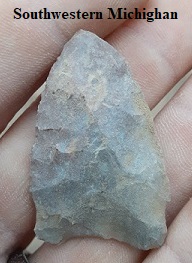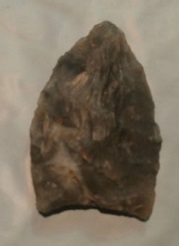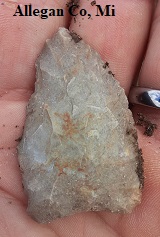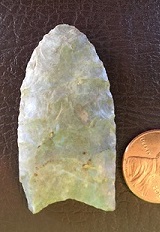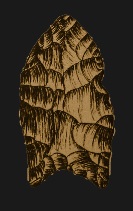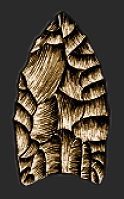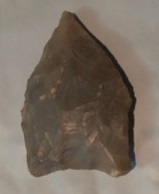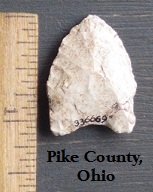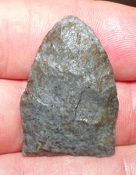Outline is Representative of Size and Shape:
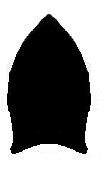
Name Details:
Identified By: James E. Fitting
Named For: Type Site
Date Identified: 1963
Type Site: Hi-Lo Gun Club Site, Ionia County, Michigan
Identified By: James E. Fitting
Named For: Type Site
Date Identified: 1963
Type Site: Hi-Lo Gun Club Site, Ionia County, Michigan
Point Validity:
Valid type
Fitting was an anthropologist who serves as the first state archeologist for the State of Michigan. He was a professor of Anthropology at the Case Western Reserve University and went on to earn a law degree and became a lawyer for the Navajo Nation. This point was named in a professional publication and has many professional references. This is considered a valid type.
Fitting was an anthropologist who serves as the first state archeologist for the State of Michigan. He was a professor of Anthropology at the Case Western Reserve University and went on to earn a law degree and became a lawyer for the Navajo Nation. This point was named in a professional publication and has many professional references. This is considered a valid type.
Hi - Lo Lanceolate
Cluster: Dalton Cluster Description of Physical Characteristics and Flaking Pattern:
This is a small to medium lanceolate point. The cross section may range from elliptical to being plano convex. The blade may have a "twist". The blade is excurvate with the widest portion of the blade being the midpoint. The shoulders are weak to absent. The waist is constricted with the stem being straight to slightly expanding. The constricting waist may give this point an eared appearance or a developing side notch appearance. The base has bifacial thinning flaking and may vary from slightly concave to deeply concave. Heavy basal and hafting region grinding is present on this point along with basal thinning. Many point exhibit left handed alternating edge beveling. This point ranges from a well controlled collateral flaking to a rougher parallel flaking pattern .
Size Measurements:
Length - 26 to 65 mm Width - 18 to 35 mm Thickness - 6 to 11 mm
Length - 26 to 65 mm Width - 18 to 35 mm Thickness - 6 to 11 mm
Commonly Utilized Material:
Onodaga chert, Haldimand chert, Kettle Point chert and other locally available materials. Substandard materials may be utilized.
Onodaga chert, Haldimand chert, Kettle Point chert and other locally available materials. Substandard materials may be utilized.
Additional Comments:
The exact age of these points are poorly documented with no Hi-Lo site being radiocarbon dated. Dates are based on their association with the Dalton point, The presence of basal grinding and occasional fluting, and sites on glacial beach ridges that are thought to be associated with caribou hunting (Justice, 1987)
These points were thought to be a multiple purpose tool (knives, butchering, projectile point, ect.) which is suggested by the edge beveling and degree of resharpening. Most points received heavy maintenance which may alter the appearance of this point. Many points are short, stubby, and asymmetrical from being re-sharpened many times. (Morrow, 2016).
The exact age of these points are poorly documented with no Hi-Lo site being radiocarbon dated. Dates are based on their association with the Dalton point, The presence of basal grinding and occasional fluting, and sites on glacial beach ridges that are thought to be associated with caribou hunting (Justice, 1987)
These points were thought to be a multiple purpose tool (knives, butchering, projectile point, ect.) which is suggested by the edge beveling and degree of resharpening. Most points received heavy maintenance which may alter the appearance of this point. Many points are short, stubby, and asymmetrical from being re-sharpened many times. (Morrow, 2016).
Distribution: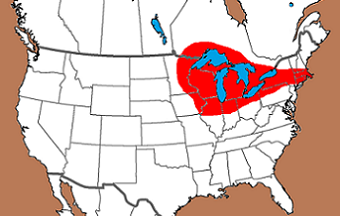

Distribution Comments:
This point is primarily found in the Great Lakes region. May be found into eastern Iowa and Minnesota infrequently as well as to the Atlantic Coast.
This point is primarily found in the Great Lakes region. May be found into eastern Iowa and Minnesota infrequently as well as to the Atlantic Coast.
Age / Periods:
Date: 10,500 - 10,000 B.P.
Cultural Period: Transitional Paleo
Glacial Period: Late Pleistocene
Culture:
Date: 10,500 - 10,000 B.P.
Cultural Period: Transitional Paleo
Glacial Period: Late Pleistocene
Culture:
Age Details:
Morrow (2016) adds additional support for the dating of this point. First, Hi-Lo points are generally considered related to Dalton points. Second, the presence of heavy basal and lateral grinding and occasional fluting suggests an early Archaic date (Ellis and Deller 1982; Deller and Ellis 1989). And third, an apparent correlation of these points in some areas with glacial beach ridges suggests great age regard Hi-Lo points as a transitional form between Late Paleoindian and Early Archaic point types.
Morrow (2016) adds additional support for the dating of this point. First, Hi-Lo points are generally considered related to Dalton points. Second, the presence of heavy basal and lateral grinding and occasional fluting suggests an early Archaic date (Ellis and Deller 1982; Deller and Ellis 1989). And third, an apparent correlation of these points in some areas with glacial beach ridges suggests great age regard Hi-Lo points as a transitional form between Late Paleoindian and Early Archaic point types.
Other points in this cluster / Related / Associated Points:

